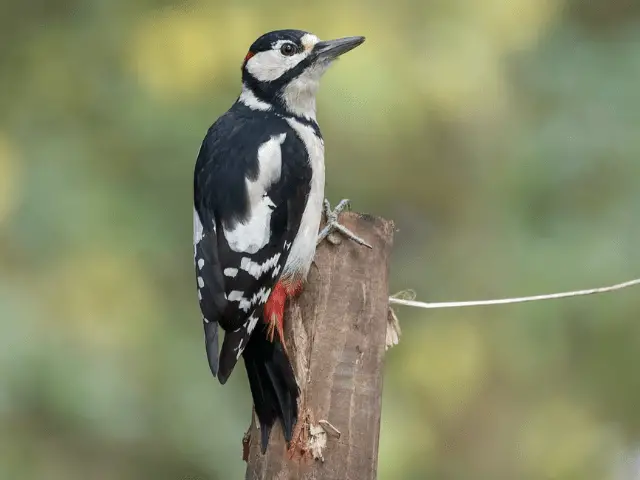If you want to go birding in VA, the woodpecker should be top on your list.
Why?
The US has 23 species, and you can see eight of them in Virginia's birding zones. Of these, seven have a resident population. Additionally, among the eight are rare ones that you can only see in this state.
So, which species await you in Virginia?
Let's look at the types, features, and habitats of woodpeckers in Virginia as you prepare for your birding tour.
Woodpeckers To See in VA
1. Pileated Woodpecker
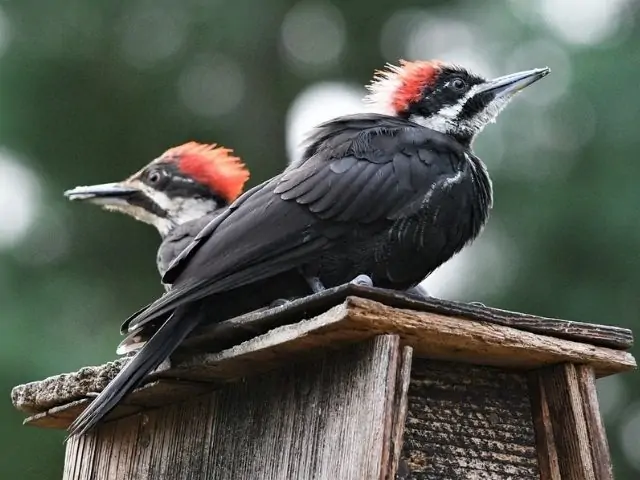
If there's one you won't forget when you see it, it's the pileated woodpecker. True, the northern flicker has different plumage from the usual black and white hues of woodpeckers, but the pileated has the most prominent crest.
The males have a red stripe across the cheek, and both sexes have a large body with white stripes from the face down. Further, it grows between 15.8 and 19.3 inches long with a wingspan between 26 and 29.5 inches.
Birders in the western states have to travel east to see it; therefore, you're lucky there's a resident population in VA.
You'll know it's in the forest you're exploring by the type of holes it left behind, as it prefers rectangular to circular. Sometimes, it drums so deep looking for ants that the tree breaks. That's why other birds love it because it does all the hard work by excavating with its large bill.
2. Downy Woodpecker
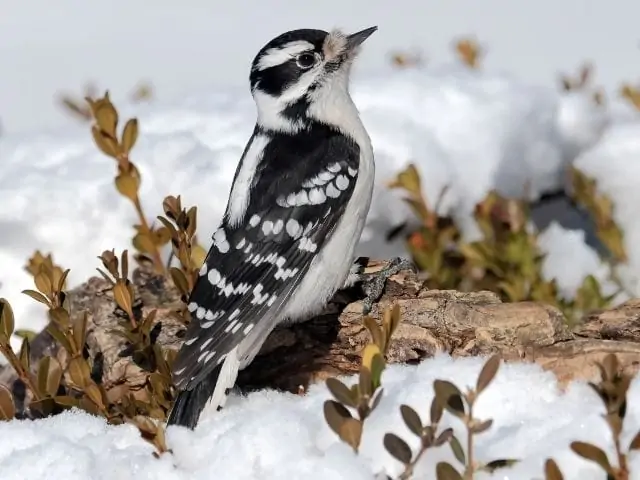
It's tiny, about 5.5 to 6.7 inches long, but it's as noisy as other woodpeckers. It's the smallest of all woodpeckers in the US, an advantage when searching for food in places the others can't reach.
You'll see the downy woodpecker in VA any time of the year, and if there are bird feeders on your property, there's no need to go looking for it in the forest. But, if you don't have a suet feeder, go birding in open woodlands, parks, and orchards.
Male birds have a short bill, a white back, black wings with white spots, and red nape. The females, on the other hand, don't have such a colorful nape. Their underbelly looks brownish-gray.
3. Northern Flicker
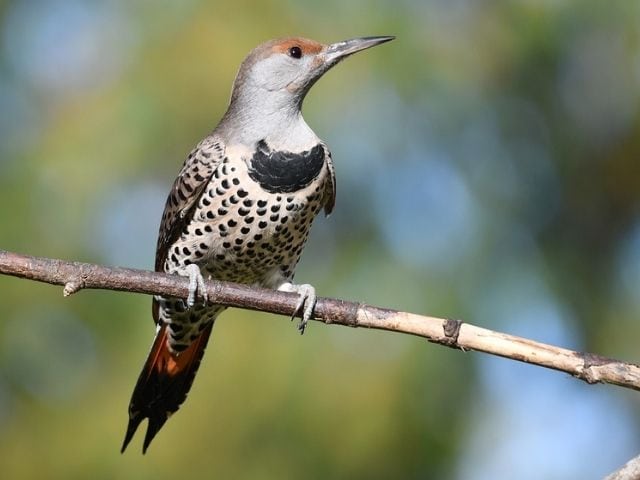
It has different plumage from others on this list as you'll come across either a yellow or red-shafted northern flicker. The yellow-shafted male has a red nape, black whisker, and bib, while the female has a bib and no patch on its nape.
The yellow-shafted male has a red whisker and black bars contrasting brownish-gray upper parts. The females are even more picturesque, with a spotted underbelly and a peachy-brown face. The ones in Virginia have yellow shafts.
The northern flicker, also called Colaptes auratus, is a large woodpecker that grows between 11 and 12.2 inches long. Its wingspan ranges from 16.5 to 20.1 inches, so it's larger than the hairy avian friend. It eats beetles, insects, fruits, and seeds. That's like the diet most birds eat.
Plus, it hangs around carpenter ant nests looking for prey. Strangely, it prefers foraging on the ground instead of drumming trees like other birds.
It's migratory, with breeding populations in the north, but with a resident population throughout the US, including Virginia.
4. Red-Headed Woodpecker
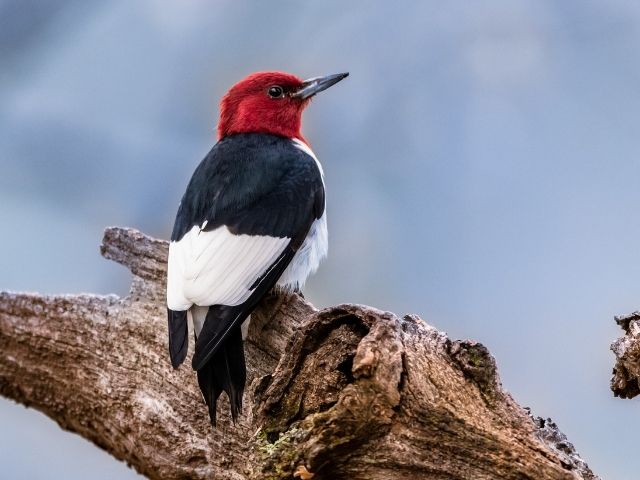
Its head is the best ID detail, as it's crimson from the crown to the neck. This species, also called Melanerpes erythrocephalus, has half black and half white underparts and upperparts.
In winter, it knows there's a feeder somewhere with black oil sunflower seeds or suet. If it doesn't find some, it can eat raspberries, poison ivy, even apples.
When birding to look for it, try the pine savanna or wetlands. The red-headed woodpecker is of average length, between 7.5 and 9.1 inches, and 16.5 inches from wing to wing.
5. Red-Bellied Woodpecker

It's another eye-catching feathered friend that lives only in the eastern states of the US.
The red-bellied woodpecker has a resident population; consequently, you may see it anytime you explore woodlands, pine-hardwood forests, and wetlands.
It thrives in such habitats because there's an abundance of plants, seeds, lizards, and spiders. Sometimes, it eats nestlings.
When you see a bird that's about 9.4 inches long, with a wingspan of between 13.0 and 16.5 inches, it might be a red-bellied woodpecker. Thus, go to the next step of identifying it, which is looking at its plumage.
The male and female birds are almost similar, with black and white barred upperparts, a pale underbelly, and a red crown that runs down the nape. However, the female has a red patch above the bill, a pale crown, and a red nape.
6. Hairy Woodpecker
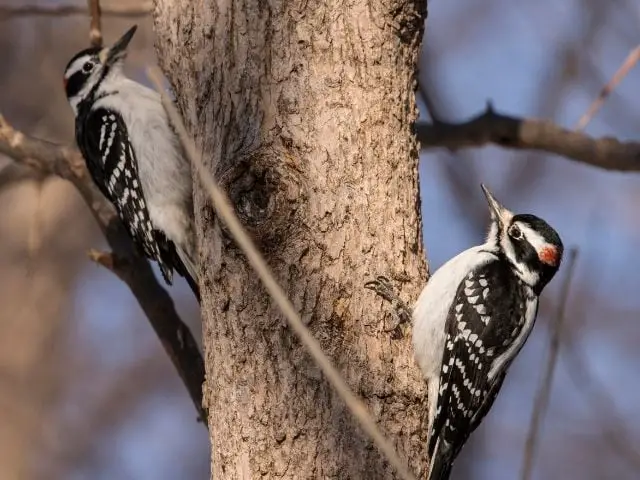
It's larger than the red-cockaded and downy woodpeckers, flaunting a wingspan of between 13 and 16 inches, while its length is 7 to 12 inches.
You may mistake it with a downy or a red-cockaded unless you spot the differences in bill size and the pattern on its head and underbelly. The male's head doesn't have the cockade mark we'll talk about below, and instead, it has a red patch.
The hairy woodpecker is a resident bird; thus, you can spot it any time of the year. Unlike the downy, this species prefers trunks instead of small tree branches.
Sometimes, it taps sap wells drilled by the yellow-billed sapsuckers. If these food sources aren't available, the hairy bird may pop into a backyard feeder for some suet.
7. Red-Cockaded Woodpecker
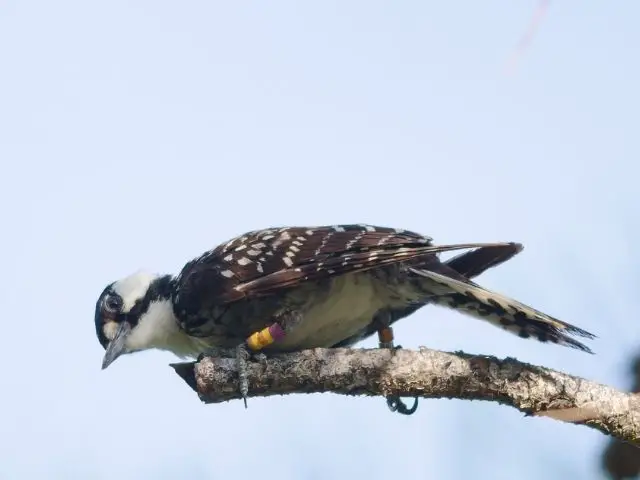
This bird, also called Picoides Borealis, is almost the size of an American robin, as it's 7.9 to 9.1 inches long. Its length from the tip of one wing to the other is about 14.2 inches for both sexes.
You'll know it's a red-cockaded bird if it has black and white stripes on its back and white cheeks. The male has an inconspicuous red streak between the cheek and straight bill. That's where it gets the name cockade.
The red cockaded woodpecker is a resident bird, but unfortunately, you have to go southeast of the state to see it. It's not common in the US anyway, as its population dots the southeastern edge, from Texas to Virginia. It's an endangered species, its population dwindling since the 70s because of the loss of habitats.
That's why in 2019, the Virginia Department of Game and Inland Fisheries (VDGIF) and conservationists banded nestlings hatched at the Big Woods Wildlife Management Area. It was the first project in this area, expanding it from the neighboring Piney Grove Preserve. The Center for Conservation Biology also participated.
How do you know there's a red-cockaded woodpecker around?
You'll see sap wells flowing in mature longleaf pine trees near their nesting ground. That's in areas with little to no undergrowth or dense vegetation, usually in areas with recent wildfires.
Such habitats are becoming extinct, and so is this endangered woodpecker.
8. Yellow-Bellied Sapsucker
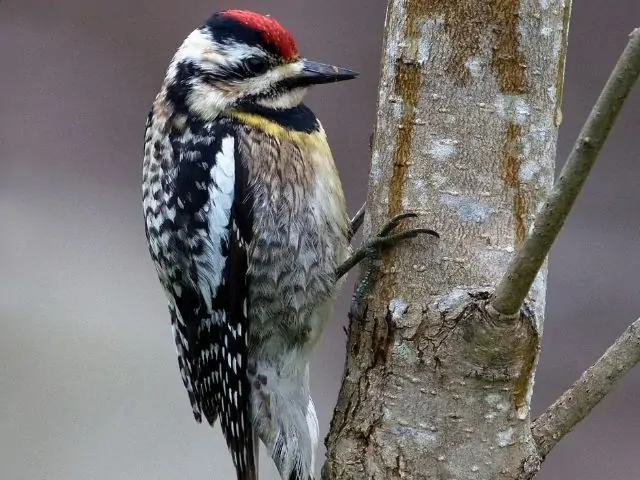
It's the only species that migrate to Virginia in winter, so it doesn't have a resident population in VA.
The yellow-bellied sapsucker is between 7.1 and 8.7 inches long, so it's a small-ish species, almost as big as the red-cockaded or the downy. Further, its wingspan is between 13.4 and 15.8 inches.
The male has a stout bill, a reddish throat and crown, and white patches running vertically on its wings. The female has a white throat.
If you see a neat row of small holes on a tree, a sapsucker is around. This species loves deciduous forests where it can drum numerous sap holes as one hole on the bark is never enough when a yellow-bellied woodpecker is around.
You may also spot it perched on the tip of a tree, catching insects.
FYI: Woodpeckers love hammering away at tree barks and branches. But what if you like them to visit your backyard instead? Read our article about how to attract woodpeckers and receive tips, tricks, and strategies to succeed!
Frequently Asked Questions (FAQs)
What Is The Biggest Woodpecker in Virginia?
The pileated woodpecker is the largest, and it can grow to over 19 inches long.
Are Woodpeckers Destructive?
Yes, because they damage trees and wooden structures by drilling holes in them. Woodpecker damage can destroy houses as they drill holes even on wood sidings and frames. Since they are cavity-nesting birds, they will build a nest in different, desirable habitats, and that's why they drill wood.
How Do I Permanently Get Rid Of Woodpeckers?
Woodpecker control includes using bird netting to prevent them from drilling holes on structures. On top of that, install artificial cavities like nest boxes to reduce their damage to trees in your backyard.
This is how to keep woodpeckers off your house:
Are Downy Woodpeckers Rare?
No, it's one of the common species, a resident in most parts of the US. It's also a regular at bird feeders for it loves seeds, nuts, and fruits.
Do Woodpeckers Eat Bird Seed?
Yes, they eat sunflower seeds, whether whole or hulled. They also come to bird feeders looking for suet, peanuts, and mealworms.
Which Is Bigger -- Downy or Hairy Woodpecker?
The hairy species is bigger, and there's also a difference in plumage. The downy's outer tail feathers have black bars, while the hairy woodpeckers have spotless white outer tail feathers.
On top of that, hairy woodpeckers have longer bills, almost the size of their head, unlike the small, stubby bills of the downy woodpecker. When you listen to their calls, the hairy bird has a sharp cry that doesn't change in level, whereas the other type has a short, high-pitched call with a descending pitch.
Final Thoughts
Birding is always exciting as you go through your ID list comparing plumage color, size, type of nest, habitat, and favorite food. These are some of the features we used to distinguish the ones we talked about in this article.
As you look for the eight woodpeckers in Virginia, you'll visit different ecosystems, from wetlands to woodlands. Some, such as the red-cockaded, live in conservation areas. Prepare for an unforgettable tour.

